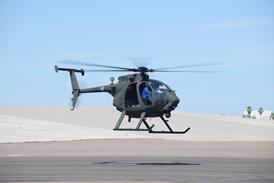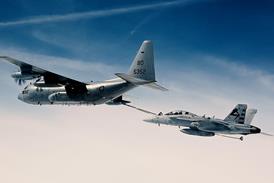Tim Furniss/BRISTOL
If a communications satellite's antennas are not pointing towards the Earth, or a space telescope's lenses are not aimed at the stars, they become not only useless, but an expensive waste of time and effort. Spacecraft only point accurately if their attitude and orbit control systems (AOCS) are working.
The AOCS has sensors which tell the satellite where it is and in which direction it is pointing. An on-board computer uses the information from the sensors to calculate the difference between the measured and required orientation, as well as actuators to alter the craft's position and attitude.
"Spacecraft are continuously subjected to a wide variety of disturbances that throw them off kilter," says David Parker, head of the guidance, navigation and control department at Matra Marconi Space (MMS), Filton, Bristol, UK.
There are external factors "-such as solar radiation pressure, gravity-gradient torques, aerodynamic drag [from the upper atmosphere which still affects craft in lower-Earth orbits], electromagnetic fields and the influence of the Moon and the Earth". In addition, on board the spacecraft the slow "flapping" of solar panels, sloshing of propellants and movements of communications-antenna dishes may all interact with the satellite's control system, Parker says.
The precise way in which the spacecraft has to be pointed depends on the type of mission. Communications satellites such as MMS' Eurostar (used for Eutelsat's Hot Bird 2 craft), need an accuracy of just 0.05 degrees. Science missions, however, "-often demand extraordinarily precise pointing", says Parker.
Vantage point
The European Space Agency's (ESA) Solar and Heliospheric Observatory (SOHO) which is observing the Sun from its vantage point 1.5 million kilometres from the Earth, requires a stability of 1arc-sec (1/3,600th of a degree) over any 15min period. "In fact, we achieved that stability for periods over 2h," says Parker.
Each science spacecraft usually requires its own unique AOCS, whereas communications satellites tend to use the same sensors, actuators and computers, but with different software for each application. MMS is streamlining the development and test processes for its communications satellites, and many new techniques will be demonstrated on the Aerospatiale-built Stentor French national technology demonstration craft to be launched in 2000.
"The one-off, science-mission, AOCS is a 'speciality of the house' at MMS Bristol," says Rob Harris, design manager for the AOCS being built for ESA's X-Ray Multi Mirror (XMM) telescope.
The XMM is an 8m-long telescope "tube" with 1,500kg mirrors and detectors at opposite ends. The telescope has to point with a stability of 0.2arc-sec over a 10s period during observations lasting up to 40h. These requirements "present a huge challenge", says Harris.
A spacecraft is constantly taking its own pulse to fix its position, using absolute celestial references such as the Earth, Sun and stars, or devices such as gyroscopes, which provide relative position.
Infra-red Earth sensors are often used on communications and remote-sensing satellites. They scan the fuzzy transition between the cold of space and the heat of the Earth to provide attitude data. Other sensors provide images of the Sun for two axes of attitude information. Simple silicon detectors can provide a rough attitude reference of 1degree accuracy with a 90 degree field of view and are used by the AOCS initially to control the spacecraft as it separates from the final stage of its launcher, or after an anomalous event somewhere else in the system.
Precise sensors
"Once coarse attitude pointing is achieved, the system can hand over control to much more precise sensors, such as fine digital Sun sensors or star trackers," says Parker. The fine Sun-sensor uses a mask consisting of a complex set of slits, covering a row of photocells, which work like the key in a lock. The angle between the Sun and the sensor - and therefore the spacecraft - determines through which particular slits the sunlight passes to illuminate the photocells.
Star trackers are more complex cameras which use a charged-coupled-device imager to detect the tiny points of light corresponding to distant stars. They provide attitude-sensing information, and at present are found only in demanding scientific and remote-sensing applications such as the MMS-built Envisat polar orbiter and the XMM.
Gyroscopes are useful adjuncts to optical sensors because they can provide information when the spacecraft is turning too quickly for optical sensors to "lock on", or when references such as the Sun are missing, for example during an eclipse. Since the information from the gyros inevitably suffers from drift because of mechanical and electronic imperfections, data have to updated using one of the optical sensors.
Most current gyros are mechanical devices and some failures have occurred over the long lifetimes required. Spare sensors are always provided because the AOCS must be able to cope with equipment or software failures in any part of its operation. New types of "solid-state" gyros such as fibre-optic, hemispherical, ones (which work like "pinging" a wine glass) and quartz rate sensors are now being introduced.
To change the position of a spacecraft, a directional force must be applied. To change the attitude, a torque is needed. Available actuators include an on-board propulsion system using thrusters, reaction wheels (flywheels about the size of a small-car wheel, turning at up to a few thousand rpm), electromagnetic coils which can interact with the Earth's magnetic field to slowly turn the spacecraft and the solar array.
MMS-built communications satellites have patented solar "sailing" systems with small flaps at the ends of the solar array, which interact with the solar radiation to produce a weak, but usable, control torque.
On current spacecraft, only the propulsion system provides directional forces, although solar sailing has also been proposed for this application in the future. The thrusters used can provide tiny bursts of force lasting perhaps only 25 milliseconds, or sustained forces for up to an hour to change satellite orbits. The effectiveness of a propulsion system is measured by its specific impulse: how much impulse is produced per unit mass of fuel.
Simple monopropellant systems are used on many spacecraft. Pressurised liquid-hydrazine propellant is decomposed over an iridium catalyst to produce a gas at about 1,000íC, which is expanded through small nozzles. For short-life, simple, spacecraft, compressed nitrogen or other cold gas can be used, but the specific impulse is only one-third as good as that of a hydrazine system.
For large, long-life, spacecraft, more-efficient bi-propellant systems are used. These employ monomethyl-hydrazine fuel and nitrogen-tetroxide oxidiser, which ignite when mixed together, in a hypergolic reaction to produce thrusts of up to 400kN (90lb).
Direct attitude control
Using propulsion systems for direct attitude control is usually not the most efficient solution. Instead, the AOCS may use reaction wheels to assimilate disturbances smoothly by absorbing in the flywheels the momentum so produced, causing them to accelerate or decelerate slowly. Similarly, by deliberately driving the wheels faster or slower, the spacecraft can be made to rotate, or slew.
This method is being used to move the XMM's aim between different star targets. "Spacecraft are powerful demonstrators of many basic laws of physics," Parker says.
The attitude-control computer's failure-detection and correction system is a constantly vigilant watchdog which monitors incipient or actual failures in other parts of the AOCS. "It is the most mission-specific part of the system because it has to be designed to cope with anything that could go wrong, and correctly decide what to do about it," Harris says.
It has to take over control and either continue the normal mission sequence or put the spacecraft into a safe condition until ground control can decide what has gone wrong. Providing safe operation of the AOCS depends on a combination of testing and computer simulation. "You cannot do a short test flight as with an aircraft. Once you've launched, it's all or nothing," says Parker.
New AOCS technology
Reaction and wheel ball-bearings require exquisite lubrication. MMS has developed ball-bearing technology in which the amount of lubrication required has been reduced to a level of a few molecules. This is the equivalent to the amount of body moisture transmitted to an object by very briefly touching it with a finger. The accuracy of machining ball bearings has been increased to a 1 micron level.
Lightweight-materials technology in spacecraft propellant tanks has made a major contribution to maximising payload weight. The Dowty Aerospace propellant tanks for the European Space Agency's (ESA's) Cluster science satellites weigh just 6kg, yet contain 130kg of propellant and sustain pressures of more than 30 atmospheres.
Engineers have been working on the concept of electric ion propulsion for over 30 years, but the technology has only been recently introduced on satellites, not for primary propulsion, but for attitude control. As communications satellites have been able to generate increased electrical power, using larger and more efficient solar panels, more of this power has been available to operate ion thrusters, which offer a much higher specific impulse than that by chemical thrusters and thus smaller amounts of propellant: the mass saving converts into a longer life or more payload. European ion thrusters will be assessed operationally on the Artemis and Stentor communications-technology satellites being developed by ESA and France, respectively. Tiny electric thrusters developed by ESA, called Field Emission Electric Propulsion devices, will be used on new astronomy spacecraft, as the quest for higher spatial resolution continues and even higher pointing stabilities down to nano-radians are required.
In the quest to give spacecraft greater autonomy to reduce the size of ground operations staff, future spacecraft will use star sensors which are able to recognise any pattern of stars without ground intervention. Working with Oxford University, MMS has demonstrated a system which can search a catalogue of 20,000 known stars in a fraction of a second and deduce the spacecraft's orientation with no previous knowledge.
Spacecraft will also have higher on-board computing power to provide this automony, while planetary landers will incorporate vision-based control systems which extract feature information in real time from digital pictures.
Source: Flight International























